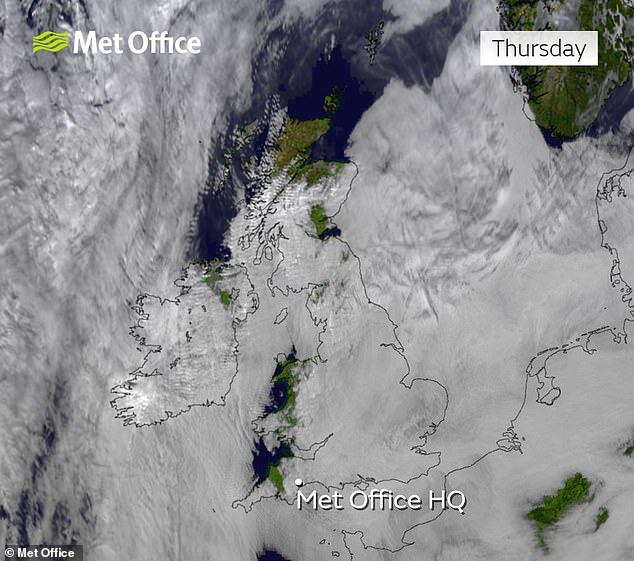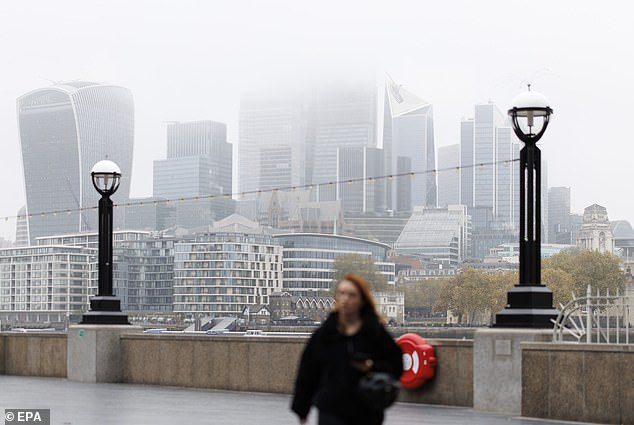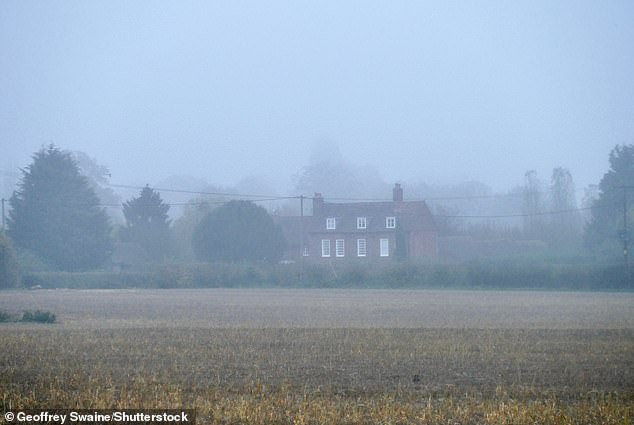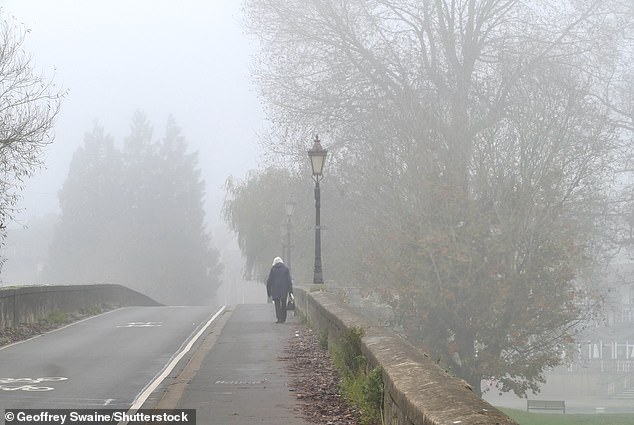Revealed: the cities with the most miserable weather in Britain that don’t get a single MINUTE of sunshine. So, is yours among them?
The unprecedented period of ‘anticyclonic gloom’ in Britain this month has resulted in the sun being completely blotted out in some areas.
Experts from the Met Office reveal that some cities in England have not had a single minute of sunshine in the first ten days of November.
Odiham in Hampshire, Saint Helier in Jersey and Ronaldsway in the Isle of Man saw no sunshine, while Rostherne in Cheshire received just 24 minutes of sunshine.
Surprisingly, Scotland, usually known for its dark conditions, experienced brighter conditions than anywhere else in Britain.
Kinloss in Moray, for example, received an impressive 35 hours of sunshine in the first 10 days of November, even reaching a ‘balmy’ 64°F (17.8°C) on Wednesday.
Overall, England had just 2.2 hours of sunshine in the first ten days of November, while Britain as a whole did slightly better with 5.3 hours.
‘Depressing’ conditions have been caused by anticyclonic gloom, a weather phenomenon characterized by gray skies, fog and low cloud.
It means that the sky is a uniformly dull color, with the sun nowhere to be seen and brightness limited during the day.
Odiham in Hampshire, Saint Helier in Jersey and Ronaldsway in the Isle of Man saw no sunshine, while Rostherne in Cheshire received just 24 minutes of sunshine

The sky is turning grey, caused by high pressure over Britain trapping moisture on the Earth’s surface, creating persistent cloud cover or, in weather terminology, ‘anticyclonic gloom’. Pictured is the effect seen from Horizon 22 in Bishopsgate, London, November 8, 2024

This satellite image from space shows Britain covered in clouds and fog. Scotland, usually known for its murky conditions, had clearer conditions than the rest of Britain
Low clouds or fog can become trapped when a cool area of high pressure moves over moist land.
The moisture then evaporates, leading to daytime fog and low cloud – an effect described by travel writer Bill Bryson as ‘living in Tupperware’.
While such an arrangement often leads to warm and sunny days with light winds in the summer months, in autumn and winter it can result in ‘anticyclonic gloom’.
In a post on
Met Office said in its X-post: ‘This week’s revulsion (is) anti-cyclonic gloom.
‘This can happen when high pressure traps a layer of moisture close to the Earth’s surface.
‘(It) brings a prolonged period of dull and cloudy weather, with fog and haze also possible. How would you describe today’s weather?’
One user replied: ‘I mean the lack of wind and rain is great, but the heavy, gloomy sky, my God, is so depressing.

Britain is in the grip of a “depressing” weather phenomenon known as “anticyclonic gloom”, experts said last week. Pictured, London, November 6, 2024

Characterized by gray skies, fog and low cloud, this means the sky is a uniformly dull color – with the sun nowhere to be seen. Pictured is a house in Dunsden, Oxfordshire, after dark on November 6

In a post on
‘It’s been the same for a whole week and your prediction is the same this week too. Just terrible, almost claustrophobic.’
Someone else said: ‘I’ve been feeling that claustrophobia for a few days. I never thought not being able to see the sky for so long would have that effect.”
Yet another said: ‘We are having a summer with little or no anticyclonic weather and when we do it is in November and depressingly dull.’
Another person asked, “Whatever happened to crisp and clear autumn days.”
Anticyclonic gloom, also known by meteorologists as a “dirty high,” typically dissipates after a week, making this last extended period unusual “but not unheard of.”
It has meant that Britain has received just five per cent of average sunshine for the month of November so far, compared to the 23 per cent normally expected at this stage of the month.
ITV weather presenter Becky Mantin said the stagnant weather of early November ’caused a staggering lack of sunshine’.
She said: ‘For some there has been no respite at all – Odiham in Hampshire has recorded zero minutes of sunshine so far in November.
‘Wales takes an unenviable second place with an average of just 12 minutes, 48 minutes recorded in Northern Ireland and only slightly more in Southern England at 54 minutes.’

A pedestrian walks through foggy weather in Wallingford, Oxfordshire, last Thursday – an effect described by Bill Bryson as ‘living in Tupperware’
According to a spokesperson for the Met Office, the gloom is easing this week and the weather is ‘looking much better at the moment’.
“There will still be cloudy days and it is still possible that we will see more widespread periods of gloomy weather,” the spokesperson told MailOnline.
“But it probably won’t be as bleak as it was last week.”
In the Met Office forecast for November 11 to 20, Met Office forecaster Alex Deakin said there will be ‘plenty of dry, calm weather’ early this week.
‘However, after a clear start, conditions are likely to become increasingly cloudy by mid-week, with isolated drizzle. Some fog is also possible, but this will slowly disappear,” Deakin said.
Later in the week it will become more unstable with some rain or showers, especially towards the east.
“After a possible brief drier spell (this weekend), it could become largely unsettled the following week,” the forecaster added.
“Temperatures will be near or slightly above average initially, but will tend to drop slightly below average later.”
The British may also have noticed particularly cold temperatures at the start of this week, slightly less mild than in November in recent years.
According to the Met Office, temperatures reached a low of 0.3C on Monday and will be even colder in the north until the weekend and early next week.
It said there was a ‘risk of frost and ice’ in some areas and even snow in the north of Britain.
